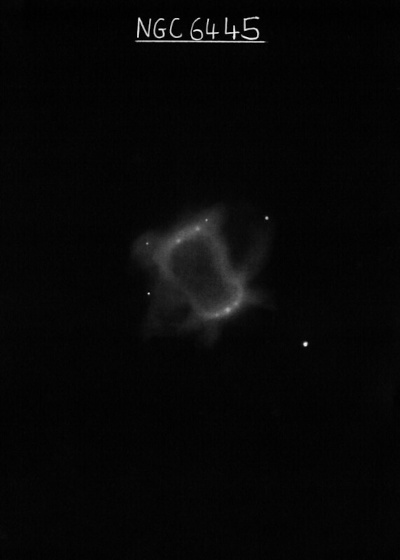Little Gem
Little Gem

William Herschel discovered NGC 6445 = H II-586 = h1986 on 28 May 1786 (sweep 569) and recorded "pB, S, iF." He placed it in his class II of "Faint Nebulae". John Herschel called this planetary "pB; pL; R; r; 40"." On 11 Mar 1848, LdR (or assistant William Rambaut) described NGC 6445 as "curious circular-shaped neb with large dark spot at one side [f side in a diagram], around which is a close cluster of well defined vS stars." Edward Pickering apparently found NGC 6445 while searching with a direct-vision spectroscope at Harvard College Observatory (Sidereal Messenger, Oct 1882). In 1887, Frank Muller reported with the 26-inch refractor at the Leander McCormick Observatory, "Two nuclei forming an elliptical nebula, elongated 150°, largest diameter 26", northern nucleus brighter. A sketch shows each nucleus to be elongated in the direction 90° +/-, the center being almost devoid of nebulosity. The nuclei are entirely separated from each other except by very faint nebulosity, and are of the 12.5 magnitude."
Based on Crossley photographs, Curtis (1918) reported "..the brighter portioin is a very irregular "square-shouldered ring 38"x29"; from this extend very faint ring like ansae in p.a. 50-230°, along which the total length is about 50". Brightest on NW edge..." Based on Helwan photographs in 1919-20, it was reported as "trapezium-shaped object with very sharp corners; the two parallel sides are considerably brighter than the other pair and lie in p.a. 60° and 240°; the NE corner is a right angle; no indication of a central star."
The Sky Catalogue 2000, Volume 2 and the Deep Sky Name Index 2000 incorrectly refer to NGC 6445 as the "Little Gem". The nickname applies to NGC 6818 (from John Mallas). John Mallas coined the nickname "The Crescent" in his Apr/May 1993 article "Visual Atlas of Planetary Nebulae-IV", but the nickname didn't stick.
200/250mm - 8" (6/27/81): fairly bright, elongated, uniform. Located within string of four mag 11/12 stars.
300/350mm - 13.1" (7/16/82): dark center at 280x appears to bisect the planetary ~E-W.
400/500mm - 17.5" (7/14/99): this bright PN is striking at 280x with a great deal of structure evident. It has a boxy appearance, elongated NW-SE with dimensions ~45"x30". The ends of the major axis are clearly brighter with a bright, shallow arc or crescent-shaped curve on the NW end. This lobe has an irregular surface brightness with a couple of brighter spots. The SE lobe is brighter but has an oddly flat edge. At 380x, the eastern end of the southeast lobe is brighter and has a small extension or nodule that bulges out beyond the rectangular outline to the east. The center is clearly darker and with careful viewing appears as a dark band running SW-NE. A mag 12 star lies ~45" NW of center and the planetary precedes a wide uneven mag 8/10.5 pair by 5'. The planetary forms an unusual pair with GC NGC 6440 20' SSW.
600/800mm - 24" (8/14/15): this highly structured planetary was observed using 500x. NGC 6445 has an unusual rectangular shape, elongated 3:2 NW-SE, with dimensions ~45"x30". The planetary is brighter in fairly narrow strips along the four sides, creating an annular appearance. The short northwest facing side is slightly brighter and contains a bright knot or section near the middle. In addition, a faint knot is at the north vertex. Another bright knot is at the east vertex and either a faint knot or very faint star is at the south vertex. The short southeast facing side is sharply defined and quite straight. A very low surface brightness glow can be seen outside (east) of the eastern vertex. In addition, with careful viewing an extremely faint outer shell or loop is outside the long southwest facing side, connected at the two vertices along this side. A mag ~15.5 star is just outside the midpoint of the loop. The outer shell or loop on the northeast side was not seen.
Notes by Steve Gottlieb